Charles Rogier Square
Charles Rogier Square (French: Place Charles Rogier, Dutch: Karel Rogierplein, usually shortened to Rogier Square, or Rogier by locals), is a major square in the Brussels municipality of Saint-Josse-ten-Noode (Belgium). It is named in honour of Charles Rogier (1800–1885), a former Prime Minister of Belgium who played a great political role during the Belgian Revolution of 1830.
 Rogier Square in Brussels | |
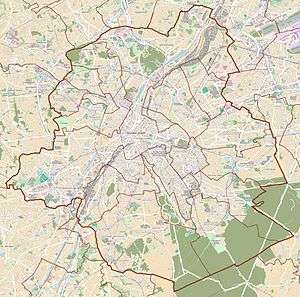 Location within Brussels | |
| Location | Saint-Josse-ten-Noode, Brussels-Capital Region, Belgium |
|---|---|
| Quarter | Northern Quarter |
| Coordinates | 50°51′20″N 04°21′31″E |
The square is located on the transition between Brussels' historic city centre (the Pentagon) and the Northern Quarter business district (also called Little Manhattan), an exponent of modern Brussels. It is an important communication node in the city both in terms of road network and public transport. Many hotels, offices and shops adjoin it. Rue Neuve/Nieuwstraat, Belgium's second busiest shopping street, also ends there.[1][2] It is served by the metro and premetro (underground tram) station Rogier.
History
Early history
The square was originally known as the Place des Nations ("Nations Square") or the Place de Cologne ("Cologne Square"). In 1885, following the death of the liberal statesman and former Prime Minister of Belgium Charles Rogier (1800–1885), it was renamed in his honour.[3]
Until 1952, the original Brussels-North railway station was located on Rogier Square. With the commissioning of the North–South connection, this terminus station was replaced, further north, by the current transit station. The old station building was demolished in 1955. The 117-metre-high (384 ft) Rogier International Center (French: Centre International Rogier, Dutch: Internationaal Rogiercentrum), also called the Martini Tower, was erected in 1960 on the former site of the station, and housed the National Theatre of Belgium until 1999. The building was demolished in 2001, and replaced by the Rogier Tower.[4]
Redevelopment (2008–2017)
In 2006, the Brussels-Capital Region decided to completely redevelop the square. The renovation lasted from 2008 to 2017, with most of the work carried out in 2013–2015. The project was the subject of an international architectural competition, with some of the entrances to the metro station also being opened and renovated.
Above the station, a large parasol-shaped translucent awning was built according to plans by the architect Xaveer De Geyter. The construction weighs 200 tonnes and has a diameter of 64 metres (210 feet).
Location and accessibility
Rogier Square lies at the conjunction of Avenue du Boulevard/Bolwerklaan to south with two smaller streets on its northern side; Rue du Progrès/Vooruitgangstraat and Rue de Brabant/Brabantstraat. Additionally, two sides streets lead into it from the north-west and north-east; Rue des Croisades/Kruisvaartenstraat and Rue Saint-Lazare/Sint-Lazarusstraat.
Notable buildings
Rogier Square is home to an important architectural heritage:
- the Palace Hôtel (1909), Art Nouveau hotel by Adhémar Lener[5]
- the Hotel Indigo Brussels-City (formerly Hôtel Albert I) (1929), Art Deco building by Michel Polak and Albert Poor[6] [7]
- the Hôtel Siru (1932), Art Deco or early modernist hotel by Marcel Chabot[8]
- the Manhattan Center (1972), functionalist building by Louis Van Hove
- the Rogier Tower (formerly Dexia Tower), completed in 2006 on the site of the Rogier International Center, by Philippe Samyn and Partners and M. & J-M. Jaspers - J. Eyers & Partners
- the Covent Garden (2004–2007), postmodern building by Henri Montois
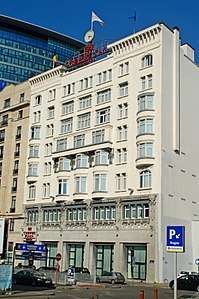 Palace Hôtel (1909)
Palace Hôtel (1909)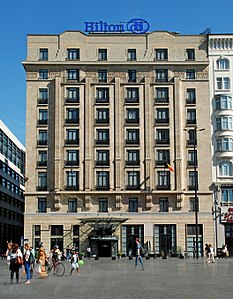 Hôtel Albert I (1929)
Hôtel Albert I (1929) Hôtel Siru (1932)
Hôtel Siru (1932)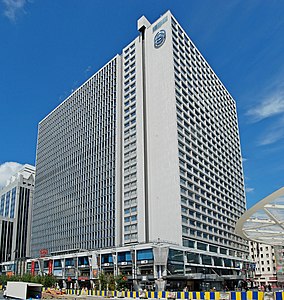 Manhattan Center, Van Hove (1972)
Manhattan Center, Van Hove (1972)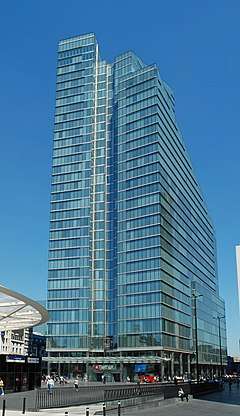 Rogier Tower, Samyn and Jaspers-Eyers (2006)
Rogier Tower, Samyn and Jaspers-Eyers (2006)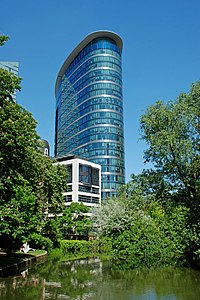 Covent Garden, Montois (2007)
Covent Garden, Montois (2007)
References
- "Rue Neuve most popular shopping street". www.xpats.com. 2013-09-19. Retrieved 27 June 2020.
- "Meir klopt voor het eerst Nieuwstraat als drukste winkelstraat". De Standaard (in Dutch). Retrieved 27 June 2020.
- "Saint-Josse-ten-Noode - Place Charles Rogier". www.irismonument.be. Retrieved 2020-06-27.
- "Dexia Tower, Brussels". SkyscraperPage. Retrieved 27 June 2020.
- "Saint-Josse-ten-Noode - Palace Hôtel - Place Charles Rogier 22-24 - Rue Gineste 3-5 - POMPE Antoine". www.irismonument.be. Retrieved 2020-06-27.
- "Saint-Josse-ten-Noode - Hôtel Albert Ier - Place Charles Rogier 17-21 - Rue Saint-Lazare 20 - POLAK Michel". www.irismonument.be. Retrieved 2020-06-27.
- |url=https://www.ihg.com/hotelindigo/hotels/gb/en/brussels/brupr/hoteldetail|access-date=2020-08-14
- "Saint-Josse-ten-Noode - New Hôtel Siru, ancien Nord Hôtel - Rue du Progrès 1 - Rue des Croisades 2-4 - CHABOT Marcel". www.irismonument.be. Retrieved 2020-06-27.